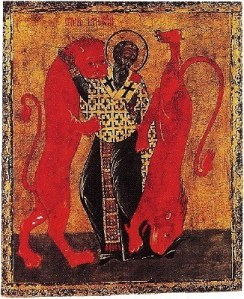 St. Ignatius the Theophorus (“the God Bearer”) is celebrated on December 20. He is believed to have been the infant that Christ took in His arms and given as an example of humility to His Apostles (Matthew 18, 2:4). The name “God Bearer” comes from his testimony in one of his epistles, where he says that he “bears Christ in his heart”. Tradition says that Ignatius was Bishop of Antioch, the third in succession to the bishop’s see, the first one having been the Holy Apostle Peter, and the second one, Evodius, according to testimonies by Eusebius, Origen, and Jerome.
St. Ignatius the Theophorus (“the God Bearer”) is celebrated on December 20. He is believed to have been the infant that Christ took in His arms and given as an example of humility to His Apostles (Matthew 18, 2:4). The name “God Bearer” comes from his testimony in one of his epistles, where he says that he “bears Christ in his heart”. Tradition says that Ignatius was Bishop of Antioch, the third in succession to the bishop’s see, the first one having been the Holy Apostle Peter, and the second one, Evodius, according to testimonies by Eusebius, Origen, and Jerome.
Because he did not want to renounce his faith in Christ, he was thrown into the arena and was torn to death by lions, around 110, during Trajan’s reign (98-117). Parts of his relics are found in the Bishopric in Galati, at the Darvari Skete in Bucharest, and at Tismana Monastery (all in Romania).
Unfortunately, what everyone retains today is solely the pig slaughtering. I don’t know what the origin of that custom is. Some researchers say that this ritual of pig stabbing wasn’t done for the purpose of feeding one’s family, since it reminded of the sacrifices to the gods, who would be “born” and would “die” again during the periods of renewal of the calendar. Which is why on Ignatius’ day, each member of the family would be marked with a cross out of the pig’s blood and it was said that it was good to see blood on that day… Continue reading